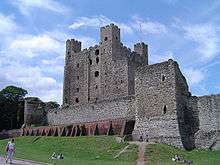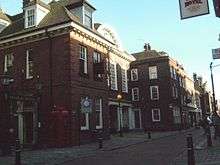Rochester (England)
Rochester is a small cathedral city on the River Medway in the north of the English county of Kent. Together with its neighbouring towns of Chatham and Gillingham it forms a large urban area known as the Medway Towns.

Get in
By car
- From London, take the A2 arterial road (32 miles, 51 km).
- From Canterbury, take the A2 and the M2 to Junction 3 for the Rochester exit (32 miles, 51 km, about 40 min).
Park and ride facilities are available on Saturdays only: see National Park and Ride Directory.
By train
🌍 Rochester Station (RTR) is outside Rochester High Street, on Corporation Road. The station was relocated in December 2015 to allow for longer trains. Trains are operated by SouthEastern from London Charing Cross (via Dartford) (typical journey time 60–65 minutes) and Victoria (typical journey time 45–60 minutes). Trains from Ramsgate and Dover also serve Rochester, although in some cases it may be necessary to change at Chatham. The Javelin high speed service operates every 30 minutes between Rochester and London St Pancras with a journey time of 35 minutes. There is a supplement for using this service unless travelling from outside of the London region.
See
Landmarks
- 🌍 Rochester Cathedral. The second-oldest cathedral foundation in England, after Canterbury.
- 🌍 Rochester Castle, Castle Hill, ME1 1SW, ☎ +44 1634 335882. open daily 10AM–6PM (April–September), 10AM–4PM (October–March), last admission 45 minutes before closing. Recognised as one of the best-preserved and finest examples of Norman architecture in England, the great keep towering over the River Medway, square, massive and one of the tallest in the country, measures 113 feet high, 70 feet square and has walls 12 feet thick in places. adults £6.40, children and concessions £4.00.
- Rochester Castle was originally a Roman castrum. A new castle was built on a hill near the site on which the castle now stands after the Norman invasion of 1066. This would have been a wooden motte and bailey type castle. In 1088 the castle came under attack in the conflict between William Rufus and Odo, Bishop of Bayeux. After William the Conqueror died in 1087 Normandy was split. Odo along with many others supported William's elder brother Robert, Duke of Normandy rather than William Rufus, the Conqueror's younger brother. Odo had control of the castle and it became the headquarters for the rebels. The castle fell to Rufus' army and Odo was forced into exile. Gundulf, the bishop of Rochester, orchestrated the creation of a stone castle alongside the cathedral. Over the centuries the castle was the scene for many conflicts including King John's attempt to regain to castle from rebellious Barons and, in 1264, Simon de Montfort's rebellion.
- By the 17th century, the castle had become neglected, the keep had been burned out, and the site was being used as a local quarry for building materials. In 1870 the castle grounds were leased to the City of Rochester, who turned them into a public park and eventually, in the 20th century, responsibility for this imposing old structure was taken over by English Heritage. Today, the castle stands as a proud reminder of the history surrounding the old town of Rochester, along with the cathedral, the cobbled streets and the Dickensian reflections.
- 🌍 Upnor Castle, High Street, Upnor, ME2 4XG, ☎ +44 1634 718742. Adults £5.80, children £3.70, concessions £3.70.
- 🌍 Eastgate House Garden, High St.. Eastgate House was built in late 16th century. The house is not open except for occasional events, but the garden is and has a Swiss chalet where Dickens used to write, moved here in the 1960s. Eastgate House appears in Dicken's books as the Nun's House in The Mystery of Edwin Drood and Westgate in Pickwick Papers.
- 🌍 Restoration House, 17-19 Crow Lane, ME1 1RF. Occasional opening. House and formal garden, dating from 1454. The house in still occupied and so is only open occasionally, usually Thurs and Fri in summer. Dickens used this as the basis for Satis House in Great Expectations. £7.50.
- 🌍 Rochester Bridge. The first bridge over the Medway to Strood was built by the Romans in 43AD. The present bridge was built in 1914, with a 1970 extension, and is worth walking across to see the views of the castle. Unusually the bridge is maintained by a charity, the Rochester Bridge Trust using investments from medieval times. There is a small chapel built into the bridge (open a few days per year) which continues a tradition started in 1393.
Museums and galleries

- 🌍 Guildhall Museum, High Street, ME1 1PY, ☎ +44 1634 848717, e-mail: guildhall.museum@medway.gov.uk. Tu-Su 10AM-4PM. Local history museum in a building dating from 1687. Free.
Do
Buy

Rochester High Street is notable for its many antiques stores. There are also a number of secondhand bookshops, notably Baggins Book Bazaar near the Guildhall Museum, which claims to be "England's largest secondhand and rare bookshop".
Eat
- 🌍 The Golden Lion, 147–149 High Street, ME1 1EL, ☎ +44 1634 880521. M-Th 7AM-midnight, F Sa 7AM-1AM, Su 7AM-midnight. Wetherspoon pub with reasonable bar meals. A main course and a drink is generally under £10.
Drink
- 🌍 Eagle Tavern, 124 High Street, ME1 1JT. Friendly pub, nice food, with live music on Thursday evenings and live jazz on Sunday lunchtimes. DJs on Friday and Saturday. mains from £7.
Sleep
- The Golden Lion, 147–149 High Street, ME1 1EL, ☎ +44 1634 880521. 9-room hotel attached to this Wetherspoon pub. from £39.
- 🌍 Gordon House Hotel, 91 High Street, ME1 1LX, ☎ +44 1634 847034. 14-room hotel in a 17th-century building on the historic High Street. Double from £70.
Go next
| Routes through Rochester |
| London ← merges with |
NW |
→ Chatham → Dover |